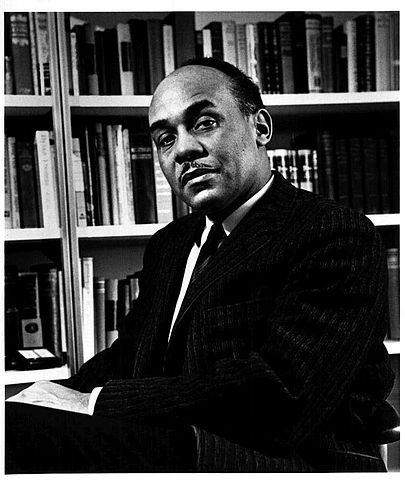
Each time I plunge back into this book, I feel the battering that Invisible Man endures when he is thrust into the “battle royal.” Our unnamed narrator, thinking he has arrived at a meeting of his town’s white business and civic leaders to receive a prestigious scholarship, is thrown into a boxing ring blindfolded with other young black men for the white men’s grotesque pleasure. The violence of this scene caught me off guard on my first reading: Why would an author require a reader to wade through these visceral scenes of blood and pummeling? Despite my discomfort, I managed to get through the violence of the first scenes to the passages of psychological abuse.
Ellison does not shy away from the brutality of his protagonist’s life in the Deep South and Harlem in the years before World War II, or from scenes that shock both readers and narrator. But for me, these scenes are not about shock value. The images and events of Invisible Man sear into the imagination—and in that raw space find a means to open us up to a deeper understanding of the dehumanizing experience of racism. Invisible Man, as great works of literature so often do, expands our experience beyond our own, thus nourishing our capacity for empathy and understanding.
During each journey I have taken through this text with different groups—from energized secondary school students in an urban American setting to an international community of writers and academics in Paris—I have witnessed how the deep engagement the novel requires of the reader repays itself many times over in the form of new insights into the self, the other, and the shared blood between. Through writing that is at turns lyric, funny, jagged, highly imagistic, and always rich, the narrative perspective of the Invisible Man moves from a dangerous naiveté to a world-weary understanding—and we trace this development alongside him.

Ellison, like so many writers before and after him, used his art to directly fight against the dehumanization of the black community in the United States. He manages to encapsulate the history of American black culture, but does so through metaphor and episode rather than a didactic presentation. He also understood that to help his readership comprehend the tragedy of racial inequality, he needed to find common experience to bridge (apparent) racial differences. Each of us knows the struggle to bring the self we cradle inside to the surface of a disinterested world. Ellison traces that struggle through the machine of mid-century segregation in America, but it persists across time and space to mark our own lives. In what ways are we invisible to others? How often do we fail to see another being in the fullness of their selfhood? Ultimately, Invisible Man takes the impressions projected onto him by the whites he encounters and, Matrix-like, bends these to create his own livable space. What price does our society pay when identity cannot be claimed freely?
For Ellison, the goal is nothing less than a new kind of novel that reveals to us the profoundest truths of our nature. In his acceptance speech upon receiving the 1953 National Book Award for Invisible Man, he states: “I was to dream of a prose which was flexible, and swift as American change is swift, confronting the inequalities and brutalities of our society forthrightly, but yet thrusting forth its images of hope, human fraternity, and individual self-realization. A prose which would make use of the richness of our speech, the idiomatic expression, and the rhetorical flourishes from past periods which are still alive among us. Despite my personal failures there must be possible a fiction which, leaving sociology and case histories to the scientists, can arrive at the truth about the human condition, here and now, with all the bright magic of the fairy tale.”
The experience of reading this book, a creation unlike anything that came before it in American literature, means bringing into our imagination the totality of the American experience across the racial divide. It is there, in the depths of our consciousness, that greater humanity may emerge.
I hope you’ll join me for Invisible Man: Claiming Identity Against Racism
– Toby


